Wim van Velzen photography - articles
NEDERLANDS |
home |
new |
landscape |
articles |
sitemap |
about |
contact
© Wim van Velzen, December 2003
Ceud mìle Fàilte
travelling in Scotland - part 2
In part one:
In this part:
church, post, bank, toilet: facilities
There are many facilities for the local population, that are great for tourists too. The following list is, of course, by no means complete. For instance, I say nothing about medical care, because I, luckily, have no experience with it. As long as you have use of a car, there is always care within easy reach. Walkers and cyclists will be able to manage a trip to a doctor or dentist, if need be.
church
I am a practised church-goer, and when on holiday I like to visit a local community. In Scotland, lots of tastes can be catered for (it is in many ways like the Dutch situation). One thing they have in common is a friendly, open character. Once I wanted to attend a Gaelic service, but as soon as they saw that I didn't understand a word of Gaelic, they turned the service into English. Not what I meant at all, but nevertheless very compliant.
The number of people attending church services is around 10%, that is even lower than in the Netherlands. Some areas in the Highlands and Islands have a far greater number though. Communities tend to be small, with around 20-80 active church members. Not surprisingly so, when a place with a population of 1000 is thought of as large.
The largest church, or kirk as it is known in Scots, is the Church of Scotland, comparable to the Dutch Reformed Church: the church is Presbyterian, the liturgy is rather austere. The sermon is central to the service.
Particularly in Argyll and the cities, the Scottish Episcopal Church can be visited; that is the sister church of the Anglican Church of England. The liturgy is more elaborate, more like the Roman Catholic Church.
Catholic churches are most numerous in the cities, as about a century ago many Irish immigrants got to work in Glasgow and the other cities. Some areas, like the southern Outer Hebrides, remained Catholic through the centuries.
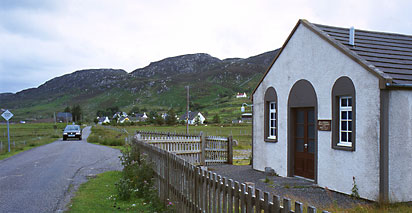 In the Highlands and even more on Skye, Lewis and Harris, the stricter versions of the Church of Scotland flourish, like the Free Church and the Free Presbyterian Church.
The liturgy is very austere - only psalms are sung, without any organ or other instrument.
In the Highlands and even more on Skye, Lewis and Harris, the stricter versions of the Church of Scotland flourish, like the Free Church and the Free Presbyterian Church.
The liturgy is very austere - only psalms are sung, without any organ or other instrument.
Members of these churches strictly observe the Sunday's rest; in Lewis even the ferries don't sail on Sundays and public life, apart from going to church, is silent.
By the way, these churches were of prime importance in the social history of Scotland, because they stood up for the crofters, giving the poor a voice.
There are here and there Baptists and other Evangelical communities, mainly in the somewhat larger places.
post and phone
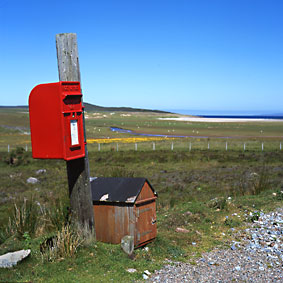 The well-known red letter boxes can be found everywhere. Stamps can be bought in many (small) shops, as well as in the post offices and agencies.
The well-known red letter boxes can be found everywhere. Stamps can be bought in many (small) shops, as well as in the post offices and agencies.
I am sorry to say that the red phone booths are often being replaced by ugly shower cabins, although the former still can be found in more picturesque surroundings.
Calling to the Netherlands works well and easy. In the evening it is cheaper than during office hours. Stay away from booths on some campsites and holiday parks. These cost about double the normal fee!
banks
Every town and city of size does have one or more banks. Still, in some areas there are no such places, so take care if you hike or cycle. Get your money in time.
Almost all banks have ATMs, auto teller machines, also known as cash machines. Getting money out of the wall is as easy as it is at home. It costs even less, than getting your money in advance in the Netherlands, although transactions costs are around 1 to 2 euro.
Larger services along the motorways have ATMs as well.
Because of the increase in money-out-of-the-wall, things like traveller cheques are fast becoming relics of the past now. The infrastructure though is still there.
Paying by credit card is no problem in (larger) shops and at most restaurants and hotels.
toilets
This is actually a subject, I would like to leave to your own discretion, were it not that Great Britain has a large number of public conveniences, and all well signposted.
This is very convenient indeed, although the quality can differ rather. The quality is most of the time more than adequate! These toilets come in very handy when you are camping for free, like in Shieldaig, where even warm water is available.
museums, castles and visitor centres
Per head of the population, Scotland has like the entire United Kingdom a very large amount of museums and exhibition rooms. There is a lot to see indeed, although I sometimes think that every owner of a stately home just raises a banner, puts some fuchsias on the stairs and then asks £ 3,- from each visitor.
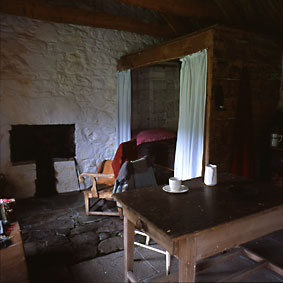 In general there are many excellent museums, castles, churches etc. you can visit. Very large ones in the cities, sporting very good art collections, to nice, snug local museums and a lot of country life or island life. Castles in particular can be found in all sizes and to everyone's taste - ruins or in perfectly good shape. Most ruins can be visited without paying, though!
In general there are many excellent museums, castles, churches etc. you can visit. Very large ones in the cities, sporting very good art collections, to nice, snug local museums and a lot of country life or island life. Castles in particular can be found in all sizes and to everyone's taste - ruins or in perfectly good shape. Most ruins can be visited without paying, though!
Certainly worth a visit are the visitor centres near nature reserves and other areas of special natural interest. Lots of information on geology, ecology and history of the land. Often there are films and nature displays as well.
These centres are generally not that expensive and offer great value. Books and tourist gimmicks are sold too.
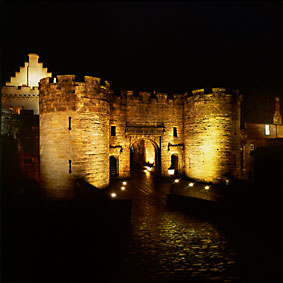 All this beauty doesn't come cheap though. Some small museums only charge one pound, no problem, but Stirling Castle can only be entered (unless you take more armed men with you than Bonny Prince Charles) after paying £ 7,50 per adult!
All this beauty doesn't come cheap though. Some small museums only charge one pound, no problem, but Stirling Castle can only be entered (unless you take more armed men with you than Bonny Prince Charles) after paying £ 7,50 per adult!
Speaking for myself, I don't mind too much. Maintaining the country's history and art does cost some money, but you have to plan your visits with some caution.
By the way, for some weird reason my willingness to part with my money has some positive relation to the amount of precipitation...
Some personal favourites:
Museums: the
archaeological museum of Kilmartin; several museums of country life, especially on the islands. A special one is Auchindrain, near Inverary (Argyll). A very well preserved and managed township, where it seems the house owners of 80 years ago could walk in - and you wouldn't be surprised!.
Castles: Tioram Castle in Moidart (ruins and free - also the one at the top of the article), Duart Castle on Mull, Stirling Castle with excellent restored Renaissance interiors.
Churches: just a few churches are all day open for visitors, but the (Presbyterian) cathedrals of the larger cities can be visited.
I especially liked St. Mungo's in Glasgow and St. Giles' in Edinburgh. Also very nice are the numerous chapels, often in ruins, that can be found everywhere along the west coast and on the islands. In recent years many of these have been re-roofed, and beautiful medieval grave stones are shown inside, to protect them against the elements. Many of these can be found in Kintyre and Argyll.
Visitor centres: Glenmore on Ardnamurchan and the one near Glencoe are very good, but actually all are - if you love nature. I cannot imagine someone who goes to Scotland and who doesn't!
climate, weather and midges: be prepared!
As soon as you tell your family, neighbours or colleagues you're going to Scotland for holidays, they probably will say two things: 'it is a beautiful country, I've heard' and 'but it always rains there...'
And anyone who visited Scotland in summer will add 'and those terrible midges'.
And that is the way it is. It always rains in Scotland, and as soon as it turns a bit dry, you're eaten alive by those horrible beasts. Please, go to France of Spain. Even in Ireland we were told: 'Scotland has 9 months of winter and 3 months of bad weather!'
So please, go elsewhere - then I will enjoy Scotland all to myself!
Reality is, as more often, more complicated than that. Yes, the weather can be appalling, although most of time full of beauty. Not really recommended for worshippers of the sun, but great for everyone who likes an active outdoor holiday.
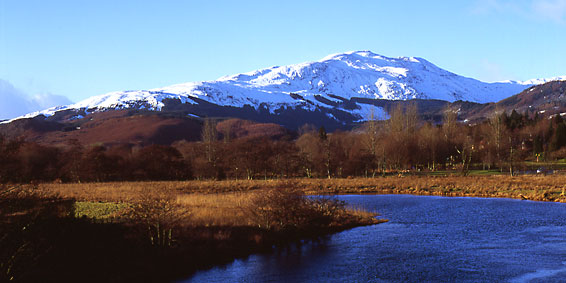 Generally the east coast has less rain than the Netherlands, the west coast about two times as much. Temperature is comparable to Holland, although summers are a bit cooler: temperatures above 25C in the west or 30C in the east are rare. In winter there is
some snow, but at sea level it melts away quickly. The mountains tend to have a white cap though for several months.
Generally the east coast has less rain than the Netherlands, the west coast about two times as much. Temperature is comparable to Holland, although summers are a bit cooler: temperatures above 25C in the west or 30C in the east are rare. In winter there is
some snow, but at sea level it melts away quickly. The mountains tend to have a white cap though for several months.
Monthly averages show a certain pattern, where May and June are drier than for instance March. But don't be surprised to have glorious days of sunshine in March and just enough light to find a tea room in May.
And this brings us to the keyword about Scottish weather: variation. It can be bright at any moment, and rain a few minutes later again. One island can have plenty sunshine and the next, just a couple of miles away, is washed away by lots of rain.
Nevertheless, you can have steady good weather. We have had sunshine for days, even on Skye, infamous for its horizontal rain, fog, snow and hail. As you see, you can never trust the Scottish weather...
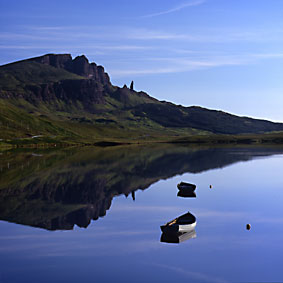
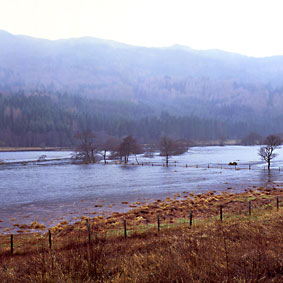
If there is more rain than we can cope with, we often go to more eastern parts of the country. A couple of years ago in September, we had had three days with terrible rain; as soon as we drove past Stirling, farmers were spraying their fields.
At the coast it can be bright, while a couple of miles from there it still drizzles. I, for instance, never saw Ardnamurchan Point in rain, while the hinterland was more than soaked...
In short: one can not rely on the weather. But more than three days of terrible rain in a two weeks holiday is rare in spring or summer. Rain clothes should always be near hand. Just don't forget your sun cream!
Of course, if you really hate the wet, you'd better go to la Méditerranée. If you can stand some rain and wind, this same wet weather can also be beautifull, full of character. Deep colours, emerald green, freshness abound.
At the west coast and even more on the islands, wind is as important as precipitation. There are more days of gales than there are on any other part of Britain. These make for fun, especially when you try to put up your tent!
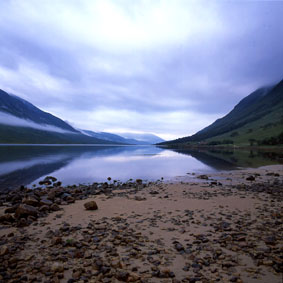 In my book the midges, or as they want to be called Culicoides impunctatus, are nastier than whatever the weather throws at you. From June to September it pleases the feminine sex of this species to lay her sting upon passing warm-blooded creatures, and they do so as a matter of team sport. It is their number in particular that makes you go crazy. Both the beasts and their bites are
mightily irritating.
In my book the midges, or as they want to be called Culicoides impunctatus, are nastier than whatever the weather throws at you. From June to September it pleases the feminine sex of this species to lay her sting upon passing warm-blooded creatures, and they do so as a matter of team sport. It is their number in particular that makes you go crazy. Both the beasts and their bites are
mightily irritating.
But! As soon as it rains, or as the sun shines or there is some wind, they don't take off. In other words, they are at their worst on overcast, calm days. Not the typical Scottish weather. Near the coast they are even rather rare.
Take care, and take some smelly repellent with you. DEET is a nice ingredient. It is really bad stuff and that is exactly what you need. I also like to use a
mosquito hat (I know it looks weird, but battles aren't won by aesthetics), for those moments when both the midges and I try to do our jobs.
language: Gaelic, Scots and English
Scottish history is more complicated than the size of the population (about 5 million people) suggests. All kinds of peoples came into the land at various moments in the past, whilst vexing each other, then and now.
This roaring past can be sensed by visitors, from the many castles, forts and derelict places. And from the linguistic situation as well. The language most used, and understood by everyone (talking about the population, not about tourists) is English - which only entered the country as late as the 17th century.
Before that, most Scots spoke Gaelic. This Celtic tongue is narrowly related to the Irish Gaelic, and a bit further to the Welsh and Breton.
Springing from the same family as most European languages, millennia ago, Gaelic looks now very cryptic to most users of English. Just try to pronounce topographical names like an 't Sron, Sgurr a'Ghreadaidh or Rubha na Creige Móire.
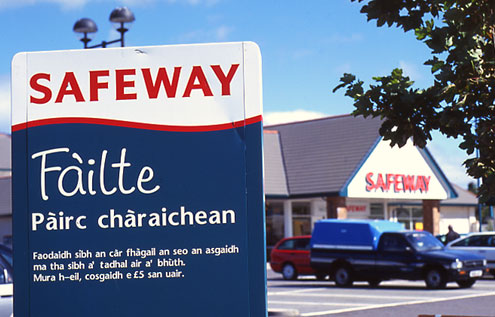 Gaelic has been losing ground to Scots and English over the course of centuries. Nowadays as little as 80,000 people are Gaelic speakers, mainly on the (Outer) Hebrides and some parts of the Gaidhealtachd (Highlands). The language sounds very melodious and has a lot of 'ch' sounds, like in Loch (unknown in English).
Gaelic has been losing ground to Scots and English over the course of centuries. Nowadays as little as 80,000 people are Gaelic speakers, mainly on the (Outer) Hebrides and some parts of the Gaidhealtachd (Highlands). The language sounds very melodious and has a lot of 'ch' sounds, like in Loch (unknown in English).
Some evil Englishmen tell that the Celtic languages originate from an unfortunate fellow who got a bucket full of mortar over his face, during the building of the tower of Babel and tried to spit it out again. This is, nevertheless, very unlikely, as that tower was built with drystone...
Despite the few number of speakers, Gaelic culture is very much alive. It has its own radio and television; there are many annual festivals too. I myself like the Gaelic music very much, with its pure singing and modest instrumentation. Far more subtle than those central Highland bagpipe bands and the My bonny is o'er the ocean-isn't-it-really-fun-to-be-in-Scotland
choirs!
Off topic here, but it seems to me that the 'typical Scottish' folklore of kilts, tartans, bagpipes and Highland games are much more popular in central Scotland, than in the west. Where the scenery is at its best, people seem to have less need of such a quasi-romantic mood, called up for tourists.
Beside Gaelic, Scots has been spoken from the beginning of the middle-ages, when Germanic tribes entered Scotland's south. Scots has been less influenced by French than English has been. It has a grammar and vocabulary of its own, even if English is used more and more. You can hear this language in the cities and lowlands, where people used it in everyday life. The rolling r and the ch, like in loch, make the sound quite distinct from English.
Scots has little or no official status.
English, spoken by Scots speaking people, can be rather difficult to understand, if you are not used to it. They speak rapidly and the accent is not really the same as the Queens' English most foreign tourists were taught at school. But you can get used to it! And actually get to love the sound.
People in the Highlands and on the isles speak English with less of an accent. Because the official English of the schools replaced in the course of time the use of Gaelic, the pronunciation is quite like the English of the BBC - not really Eton or Oxford though.
Anyway, nobody minds if a foreigner can't find the right word or if he makes mistakes with grammar, that would make an English teacher have a heart-attack. As they sometimes say to me: Your English is better than my Dutch.... They always want to repeat what they just said, albeit often with the same speed as the first time. You still have got no clue, but you can nod with even more sympathy.
Finally, I want to mention that the Orkneys and Shetlands were Norwegian
until the 15th century (the Shetlands are as close to Norway as they are to the British mainland). Norwegian is no longer in use, but it certainly left many traces in the English dialect of these islands.
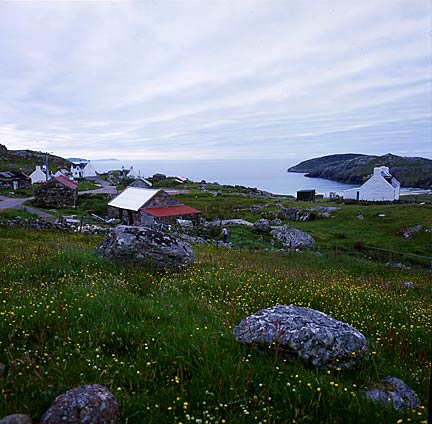
This article is written by Wim van Velzen, © 2003.
Comments on the article and photographs are welcome!
The landscape photographs shown here and lots more are put in several portfolios!
It is also possible to order landscape prints or to use them editorially or commercially.
return to top
 In the Highlands and even more on Skye, Lewis and Harris, the stricter versions of the Church of Scotland flourish, like the Free Church and the Free Presbyterian Church.
The liturgy is very austere - only psalms are sung, without any organ or other instrument.
In the Highlands and even more on Skye, Lewis and Harris, the stricter versions of the Church of Scotland flourish, like the Free Church and the Free Presbyterian Church.
The liturgy is very austere - only psalms are sung, without any organ or other instrument. The well-known red letter boxes can be found everywhere. Stamps can be bought in many (small) shops, as well as in the post offices and agencies.
The well-known red letter boxes can be found everywhere. Stamps can be bought in many (small) shops, as well as in the post offices and agencies.
 In general there are many excellent museums, castles, churches etc. you can visit. Very large ones in the cities, sporting very good art collections, to nice, snug local museums and a lot of country life or island life. Castles in particular can be found in all sizes and to everyone's taste - ruins or in perfectly good shape. Most ruins can be visited without paying, though!
In general there are many excellent museums, castles, churches etc. you can visit. Very large ones in the cities, sporting very good art collections, to nice, snug local museums and a lot of country life or island life. Castles in particular can be found in all sizes and to everyone's taste - ruins or in perfectly good shape. Most ruins can be visited without paying, though!
 All this beauty doesn't come cheap though. Some small museums only charge one pound, no problem, but Stirling Castle can only be entered (unless you take more armed men with you than Bonny Prince Charles) after paying £ 7,50 per adult!
All this beauty doesn't come cheap though. Some small museums only charge one pound, no problem, but Stirling Castle can only be entered (unless you take more armed men with you than Bonny Prince Charles) after paying £ 7,50 per adult! Generally the east coast has less rain than the Netherlands, the west coast about two times as much. Temperature is comparable to Holland, although summers are a bit cooler: temperatures above 25C in the west or 30C in the east are rare. In winter there is
some snow, but at sea level it melts away quickly. The mountains tend to have a white cap though for several months.
Generally the east coast has less rain than the Netherlands, the west coast about two times as much. Temperature is comparable to Holland, although summers are a bit cooler: temperatures above 25C in the west or 30C in the east are rare. In winter there is
some snow, but at sea level it melts away quickly. The mountains tend to have a white cap though for several months.

 In my book the midges, or as they want to be called Culicoides impunctatus, are nastier than whatever the weather throws at you. From June to September it pleases the feminine sex of this species to lay her sting upon passing warm-blooded creatures, and they do so as a matter of team sport. It is their number in particular that makes you go crazy. Both the beasts and their bites are
mightily irritating.
In my book the midges, or as they want to be called Culicoides impunctatus, are nastier than whatever the weather throws at you. From June to September it pleases the feminine sex of this species to lay her sting upon passing warm-blooded creatures, and they do so as a matter of team sport. It is their number in particular that makes you go crazy. Both the beasts and their bites are
mightily irritating. Gaelic has been losing ground to Scots and English over the course of centuries. Nowadays as little as 80,000 people are Gaelic speakers, mainly on the (Outer) Hebrides and some parts of the Gaidhealtachd (Highlands). The language sounds very melodious and has a lot of 'ch' sounds, like in Loch (unknown in English).
Gaelic has been losing ground to Scots and English over the course of centuries. Nowadays as little as 80,000 people are Gaelic speakers, mainly on the (Outer) Hebrides and some parts of the Gaidhealtachd (Highlands). The language sounds very melodious and has a lot of 'ch' sounds, like in Loch (unknown in English).